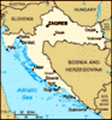Advertisement
Published: September 9th 2017
With the weather in Rovinj not looking so good today, we decided to drive to Porec. Porec is located around half an hour away from Rovinj, and has a history dating back to the second century BC, when it was a Roman Town called Castrum. With rain starting to fall, we took shelter in a cafe in Porec and warmed ourselves up with a coffee. By the time we had finished our coffee, the rain has just about ceased, so we headed for the main attraction in Porec, the Euphrasian Basilica.
The Euphrasian Basilica dates back to the third century, when the settlement had an organised Christian community. We thought it would be like many of the old churches we had visited on our trips to Europe. Not so. The mosaics are something else to see, as is demonstrated by the photos attached to our blog. The floor mosaic in the garden dates back to the 4
th Century .The mosaics in the Apse date back to the 6
th century. As part of our visit to the Basilica, we also climbed the Bell Tower. Definitely not your average Basilica.
We walked around the Old Town of
Porec, and Kim noticed a sign advertising GF meals. We stopped and enjoyed a hearty meal, before returning to the Alfa for our next mission.
On our last visit to Europe, we had visited a small cliff-hugging town in South Central France called Rocamadour. As I was taking photos of the entrance to the Black Madonna Church in Rocamadour, I noticed a very faint outline of a frescoe of two skeletons brandishing swords, which seemed at odds with a house of worship. There was no signs identifying or explaining the ancient frescoes, and thus, when I returned to our accommodation that evening, I did some research on google to try and ascertain the meaning of the frescoes.
The frescoes were a representation of the
Danse Macabre , which consists of the dead summoning representatives from all walks of life to dance along to the grave, typically with a Pope, emperor, king, child and labourer. They were produced to remind people of the fragility of their lives and how vain were the glories of earthly life. Death is the great leveler.
One of our favourite TV shows over the past year has been Francesco's
Mediterranean Voyage, with the host being Venetian Francesco da Mosta, exploring less well known regions that border the Mediterranean Sea. On one of the episodes, I recall Francesco venturing into Istria, to a little town called Beram, and knocking on the door of a resident of the town to have her open the door to a small church in the woods, one kilometre out of the town. The church is called called St Mary of the Rocks Church, and the unlit interior is covered in remarkable frescoes.
We drove up into the Istrian hills to Beram, and knocked at No. 38, however there was no answer. We enquired at the local cafe and they advised Sonja was probably at the church. We drove out to the small church in the woods, and there was Sonja inside, showing a few pilgrims the frescoes. Stooping to walk through the entrance to the church, as our eyes grew accustomed to the dim light, we were amazed at the remarkably well preserved frescoes. Sonja allowed us to take photos of the frescoes (flash off), which we proceeded to do.
The star of the show was a “Danse Macabre”
or Danse of Death” frescoe painted by Vincent de Kastav in 1474. In this frescoe, the skeletons walk in procession from right to left led by a skeleton playing a bagpipe. There are ten characters in the frescoe, each accompanied by a skeleton. After the leader march the pope, the cardinal, the bishop, the king, the queen, the innkeeper, the child, the maimed, the knight and finally the merchant, who tries to bribe Death by pointing at his money, but of course, his efforts are futile.
Sonja, the keeper of the key to the church, asked us for a lift back to Beram, which we were only too grateful to oblige. We thanked Sonja profusely for allowing us to visit this unique church, which has definitely been one of the highlights of our holiday thus far.
After dropping off Sonja at No. 38, we then drove to Pula. Pula is known for it’s multitude of ancient Roman buildings, with the most significant being the Arena, one of the best preserved Roman Amphitheatres. We visited the Arena, which towers above the city, also walking through some of the tunnels underneath the Arena where the slaves
and animals were kept whilst they awaited their call-up to the Arena.
We then walked through the streets of the Old Town, looking for the Roman Forum. Near the edge of the harbour, we located the Forum, which was also very well preserved and well worth the long walk.
A day packed with early church and Roman history, as well as tracking down one of the last remaining frescoes featuring the Danse Macabre.
Advertisement
Tot: 0.429s; Tpl: 0.021s; cc: 12; qc: 46; dbt: 0.1144s; 1; m:domysql w:travelblog (10.17.0.13); sld: 1;
; mem: 1.2mb









